Report on Implementing Hands-on Training in Construction Industry HRM
VerifiedAdded on 2021/04/16
|22
|4483
|36
Report
AI Summary
This report discusses the importance of hands-on training methods in Human Resource Management (HRM) within the construction industry. It highlights the critical role of HRM in training and developing employees to handle risks and adapt to new technologies. Various hands-on training methods are explored, including on-the-job training (OJT), simulation, role-playing, behavior modeling, and job rotation, with a discussion of their respective advantages and disadvantages. The report emphasizes the significance of providing real-world experience to learners, fostering empowerment, and enhancing learning speed. Ultimately, the aim is to equip workers with the necessary skills to reduce workplace accidents and improve overall performance, supported by strategic risk management practices.
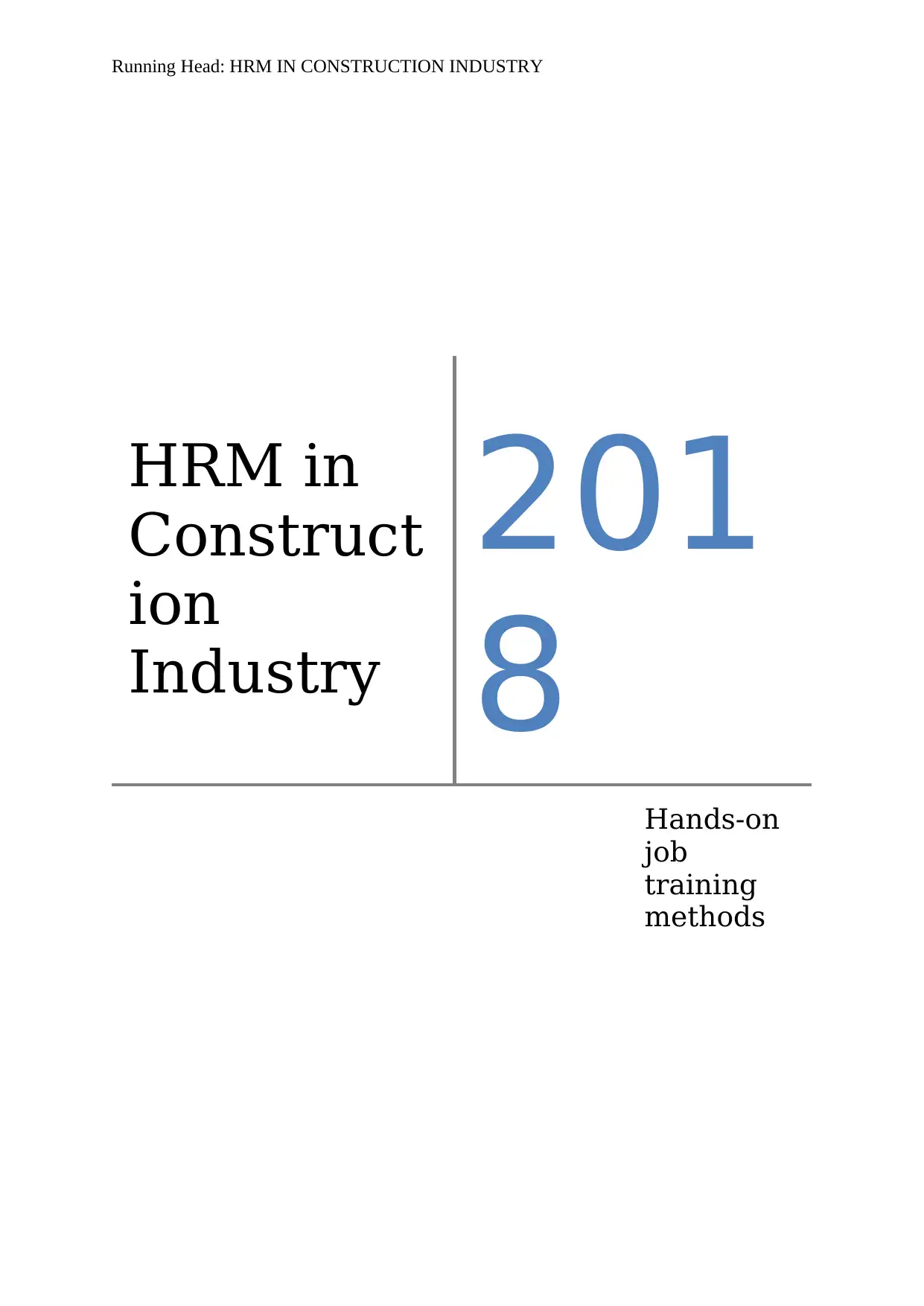
Running Head: HRM IN CONSTRUCTION INDUSTRY
HRM in
Construct
ion
Industry
201
8 Hands-on
job
training
methods
HRM in
Construct
ion
Industry
201
8 Hands-on
job
training
methods
Paraphrase This Document
Need a fresh take? Get an instant paraphrase of this document with our AI Paraphraser
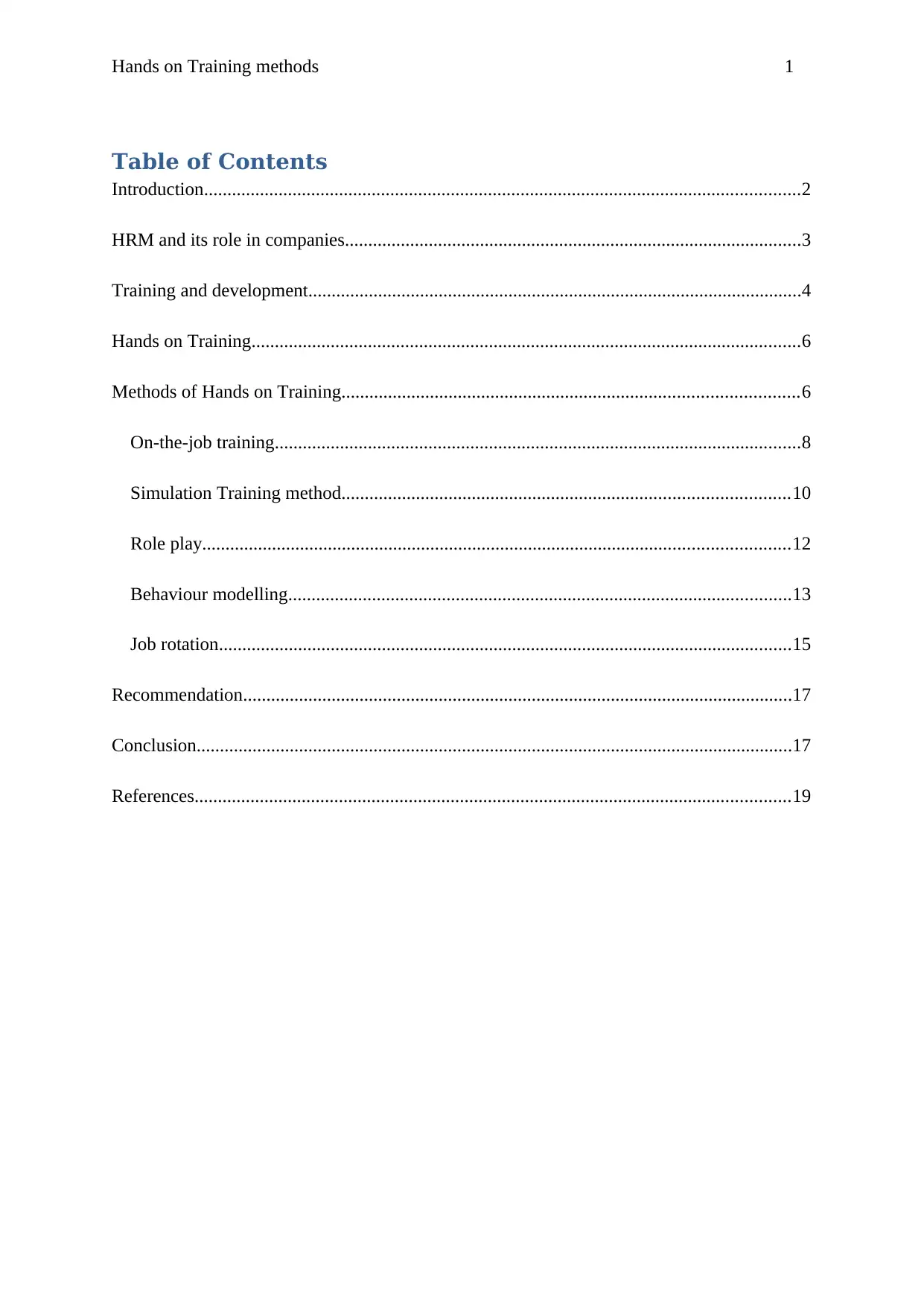
Hands on Training methods 1
Table of Contents
Introduction................................................................................................................................2
HRM and its role in companies..................................................................................................3
Training and development..........................................................................................................4
Hands on Training......................................................................................................................6
Methods of Hands on Training..................................................................................................6
On-the-job training.................................................................................................................8
Simulation Training method................................................................................................10
Role play..............................................................................................................................12
Behaviour modelling............................................................................................................13
Job rotation...........................................................................................................................15
Recommendation......................................................................................................................17
Conclusion................................................................................................................................17
References................................................................................................................................19
Table of Contents
Introduction................................................................................................................................2
HRM and its role in companies..................................................................................................3
Training and development..........................................................................................................4
Hands on Training......................................................................................................................6
Methods of Hands on Training..................................................................................................6
On-the-job training.................................................................................................................8
Simulation Training method................................................................................................10
Role play..............................................................................................................................12
Behaviour modelling............................................................................................................13
Job rotation...........................................................................................................................15
Recommendation......................................................................................................................17
Conclusion................................................................................................................................17
References................................................................................................................................19
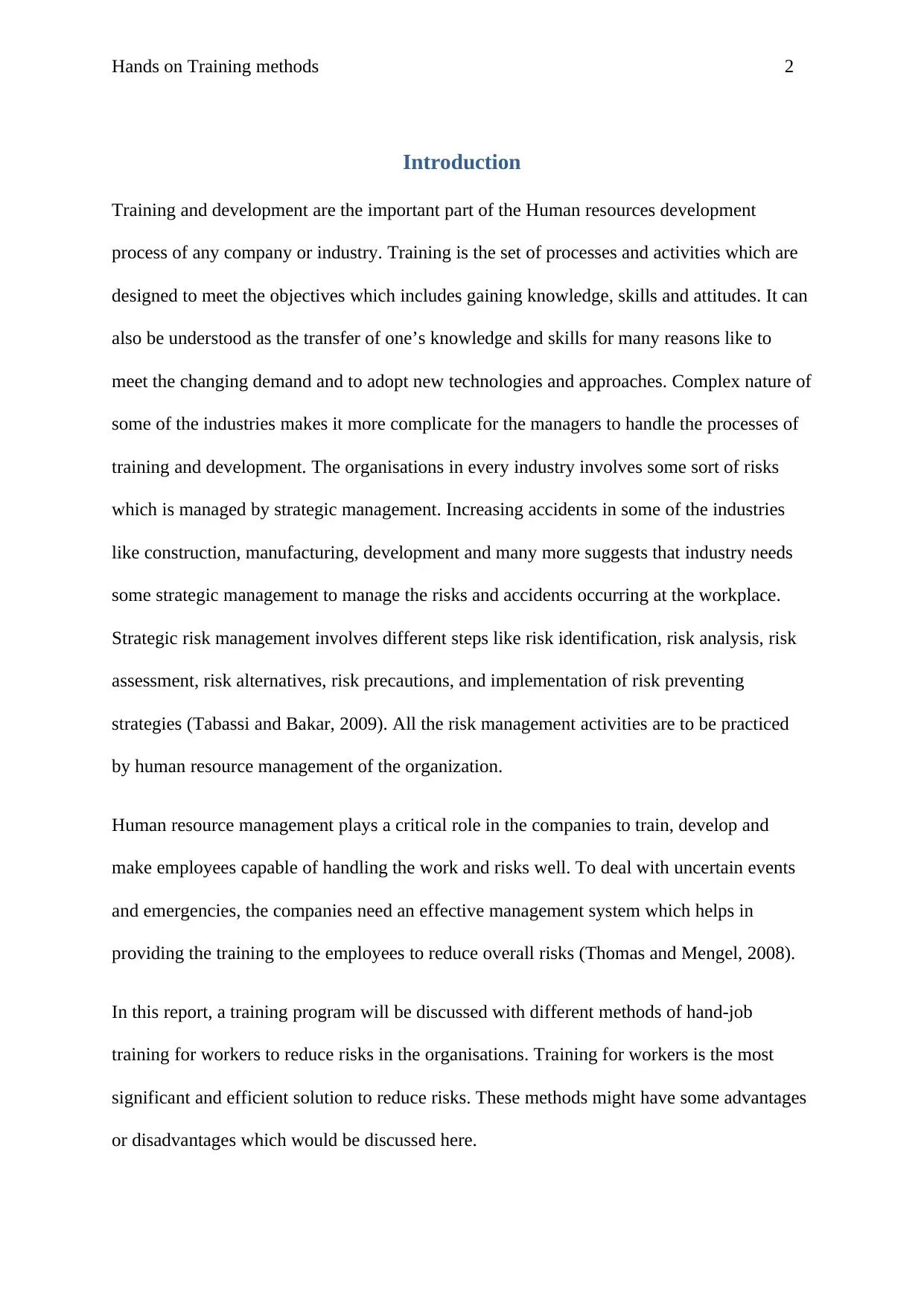
Hands on Training methods 2
Introduction
Training and development are the important part of the Human resources development
process of any company or industry. Training is the set of processes and activities which are
designed to meet the objectives which includes gaining knowledge, skills and attitudes. It can
also be understood as the transfer of one’s knowledge and skills for many reasons like to
meet the changing demand and to adopt new technologies and approaches. Complex nature of
some of the industries makes it more complicate for the managers to handle the processes of
training and development. The organisations in every industry involves some sort of risks
which is managed by strategic management. Increasing accidents in some of the industries
like construction, manufacturing, development and many more suggests that industry needs
some strategic management to manage the risks and accidents occurring at the workplace.
Strategic risk management involves different steps like risk identification, risk analysis, risk
assessment, risk alternatives, risk precautions, and implementation of risk preventing
strategies (Tabassi and Bakar, 2009). All the risk management activities are to be practiced
by human resource management of the organization.
Human resource management plays a critical role in the companies to train, develop and
make employees capable of handling the work and risks well. To deal with uncertain events
and emergencies, the companies need an effective management system which helps in
providing the training to the employees to reduce overall risks (Thomas and Mengel, 2008).
In this report, a training program will be discussed with different methods of hand-job
training for workers to reduce risks in the organisations. Training for workers is the most
significant and efficient solution to reduce risks. These methods might have some advantages
or disadvantages which would be discussed here.
Introduction
Training and development are the important part of the Human resources development
process of any company or industry. Training is the set of processes and activities which are
designed to meet the objectives which includes gaining knowledge, skills and attitudes. It can
also be understood as the transfer of one’s knowledge and skills for many reasons like to
meet the changing demand and to adopt new technologies and approaches. Complex nature of
some of the industries makes it more complicate for the managers to handle the processes of
training and development. The organisations in every industry involves some sort of risks
which is managed by strategic management. Increasing accidents in some of the industries
like construction, manufacturing, development and many more suggests that industry needs
some strategic management to manage the risks and accidents occurring at the workplace.
Strategic risk management involves different steps like risk identification, risk analysis, risk
assessment, risk alternatives, risk precautions, and implementation of risk preventing
strategies (Tabassi and Bakar, 2009). All the risk management activities are to be practiced
by human resource management of the organization.
Human resource management plays a critical role in the companies to train, develop and
make employees capable of handling the work and risks well. To deal with uncertain events
and emergencies, the companies need an effective management system which helps in
providing the training to the employees to reduce overall risks (Thomas and Mengel, 2008).
In this report, a training program will be discussed with different methods of hand-job
training for workers to reduce risks in the organisations. Training for workers is the most
significant and efficient solution to reduce risks. These methods might have some advantages
or disadvantages which would be discussed here.
⊘ This is a preview!⊘
Do you want full access?
Subscribe today to unlock all pages.

Trusted by 1+ million students worldwide

Hands on Training methods 3
Paraphrase This Document
Need a fresh take? Get an instant paraphrase of this document with our AI Paraphraser
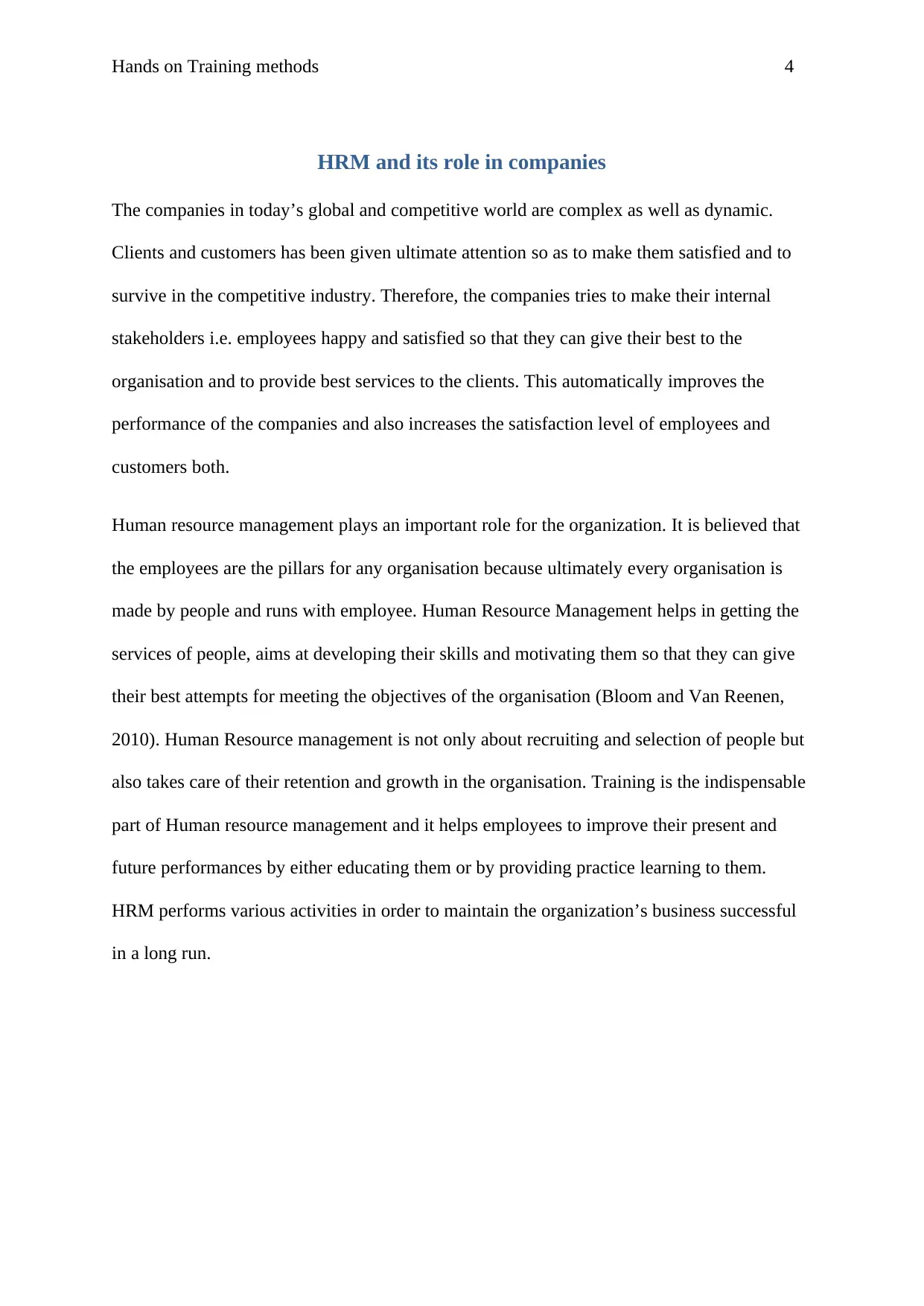
Hands on Training methods 4
HRM and its role in companies
The companies in today’s global and competitive world are complex as well as dynamic.
Clients and customers has been given ultimate attention so as to make them satisfied and to
survive in the competitive industry. Therefore, the companies tries to make their internal
stakeholders i.e. employees happy and satisfied so that they can give their best to the
organisation and to provide best services to the clients. This automatically improves the
performance of the companies and also increases the satisfaction level of employees and
customers both.
Human resource management plays an important role for the organization. It is believed that
the employees are the pillars for any organisation because ultimately every organisation is
made by people and runs with employee. Human Resource Management helps in getting the
services of people, aims at developing their skills and motivating them so that they can give
their best attempts for meeting the objectives of the organisation (Bloom and Van Reenen,
2010). Human Resource management is not only about recruiting and selection of people but
also takes care of their retention and growth in the organisation. Training is the indispensable
part of Human resource management and it helps employees to improve their present and
future performances by either educating them or by providing practice learning to them.
HRM performs various activities in order to maintain the organization’s business successful
in a long run.
HRM and its role in companies
The companies in today’s global and competitive world are complex as well as dynamic.
Clients and customers has been given ultimate attention so as to make them satisfied and to
survive in the competitive industry. Therefore, the companies tries to make their internal
stakeholders i.e. employees happy and satisfied so that they can give their best to the
organisation and to provide best services to the clients. This automatically improves the
performance of the companies and also increases the satisfaction level of employees and
customers both.
Human resource management plays an important role for the organization. It is believed that
the employees are the pillars for any organisation because ultimately every organisation is
made by people and runs with employee. Human Resource Management helps in getting the
services of people, aims at developing their skills and motivating them so that they can give
their best attempts for meeting the objectives of the organisation (Bloom and Van Reenen,
2010). Human Resource management is not only about recruiting and selection of people but
also takes care of their retention and growth in the organisation. Training is the indispensable
part of Human resource management and it helps employees to improve their present and
future performances by either educating them or by providing practice learning to them.
HRM performs various activities in order to maintain the organization’s business successful
in a long run.
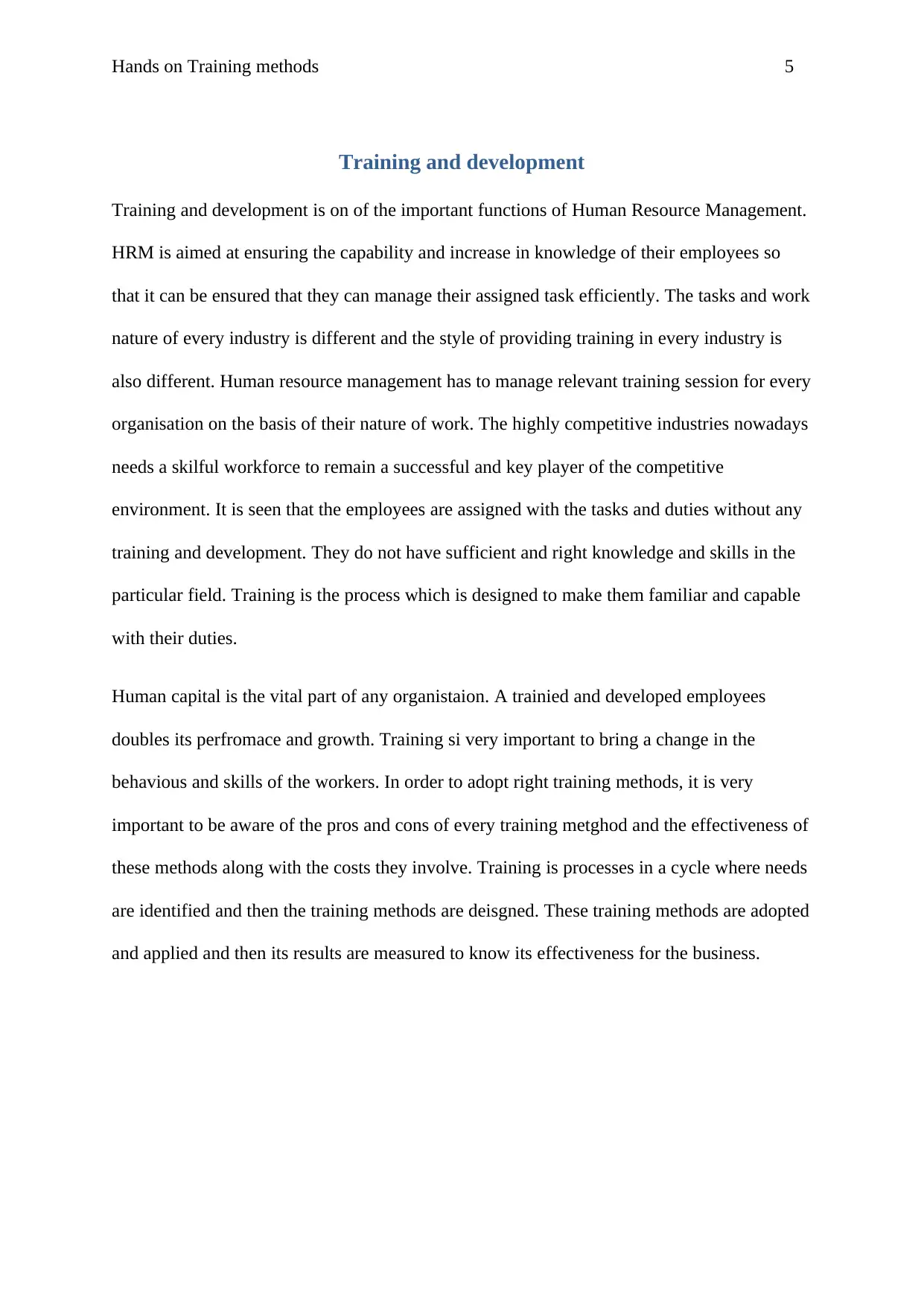
Hands on Training methods 5
Training and development
Training and development is on of the important functions of Human Resource Management.
HRM is aimed at ensuring the capability and increase in knowledge of their employees so
that it can be ensured that they can manage their assigned task efficiently. The tasks and work
nature of every industry is different and the style of providing training in every industry is
also different. Human resource management has to manage relevant training session for every
organisation on the basis of their nature of work. The highly competitive industries nowadays
needs a skilful workforce to remain a successful and key player of the competitive
environment. It is seen that the employees are assigned with the tasks and duties without any
training and development. They do not have sufficient and right knowledge and skills in the
particular field. Training is the process which is designed to make them familiar and capable
with their duties.
Human capital is the vital part of any organistaion. A trainied and developed employees
doubles its perfromace and growth. Training si very important to bring a change in the
behavious and skills of the workers. In order to adopt right training methods, it is very
important to be aware of the pros and cons of every training metghod and the effectiveness of
these methods along with the costs they involve. Training is processes in a cycle where needs
are identified and then the training methods are deisgned. These training methods are adopted
and applied and then its results are measured to know its effectiveness for the business.
Training and development
Training and development is on of the important functions of Human Resource Management.
HRM is aimed at ensuring the capability and increase in knowledge of their employees so
that it can be ensured that they can manage their assigned task efficiently. The tasks and work
nature of every industry is different and the style of providing training in every industry is
also different. Human resource management has to manage relevant training session for every
organisation on the basis of their nature of work. The highly competitive industries nowadays
needs a skilful workforce to remain a successful and key player of the competitive
environment. It is seen that the employees are assigned with the tasks and duties without any
training and development. They do not have sufficient and right knowledge and skills in the
particular field. Training is the process which is designed to make them familiar and capable
with their duties.
Human capital is the vital part of any organistaion. A trainied and developed employees
doubles its perfromace and growth. Training si very important to bring a change in the
behavious and skills of the workers. In order to adopt right training methods, it is very
important to be aware of the pros and cons of every training metghod and the effectiveness of
these methods along with the costs they involve. Training is processes in a cycle where needs
are identified and then the training methods are deisgned. These training methods are adopted
and applied and then its results are measured to know its effectiveness for the business.
⊘ This is a preview!⊘
Do you want full access?
Subscribe today to unlock all pages.

Trusted by 1+ million students worldwide
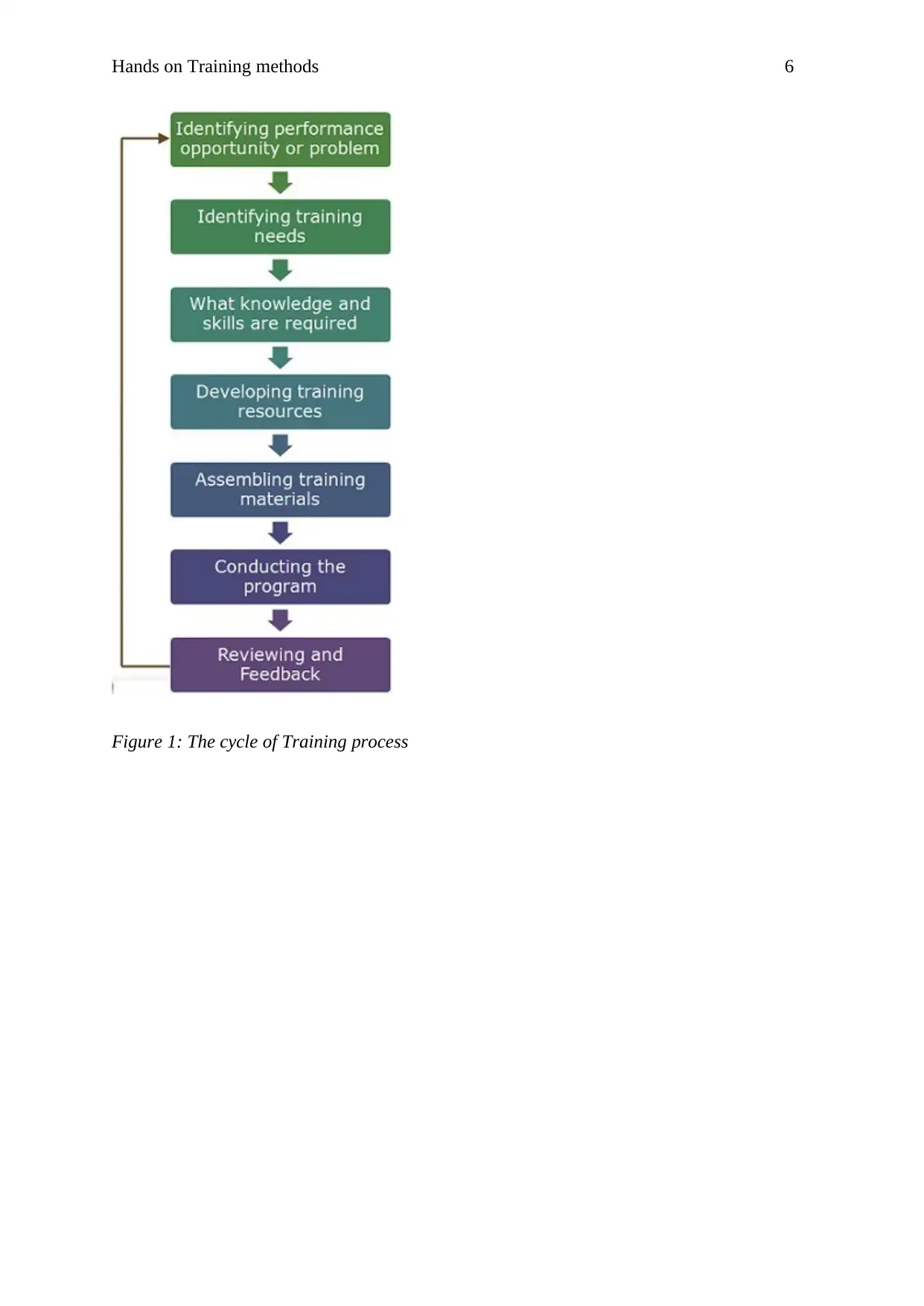
Hands on Training methods 6
Figure 1: The cycle of Training process
Figure 1: The cycle of Training process
Paraphrase This Document
Need a fresh take? Get an instant paraphrase of this document with our AI Paraphraser
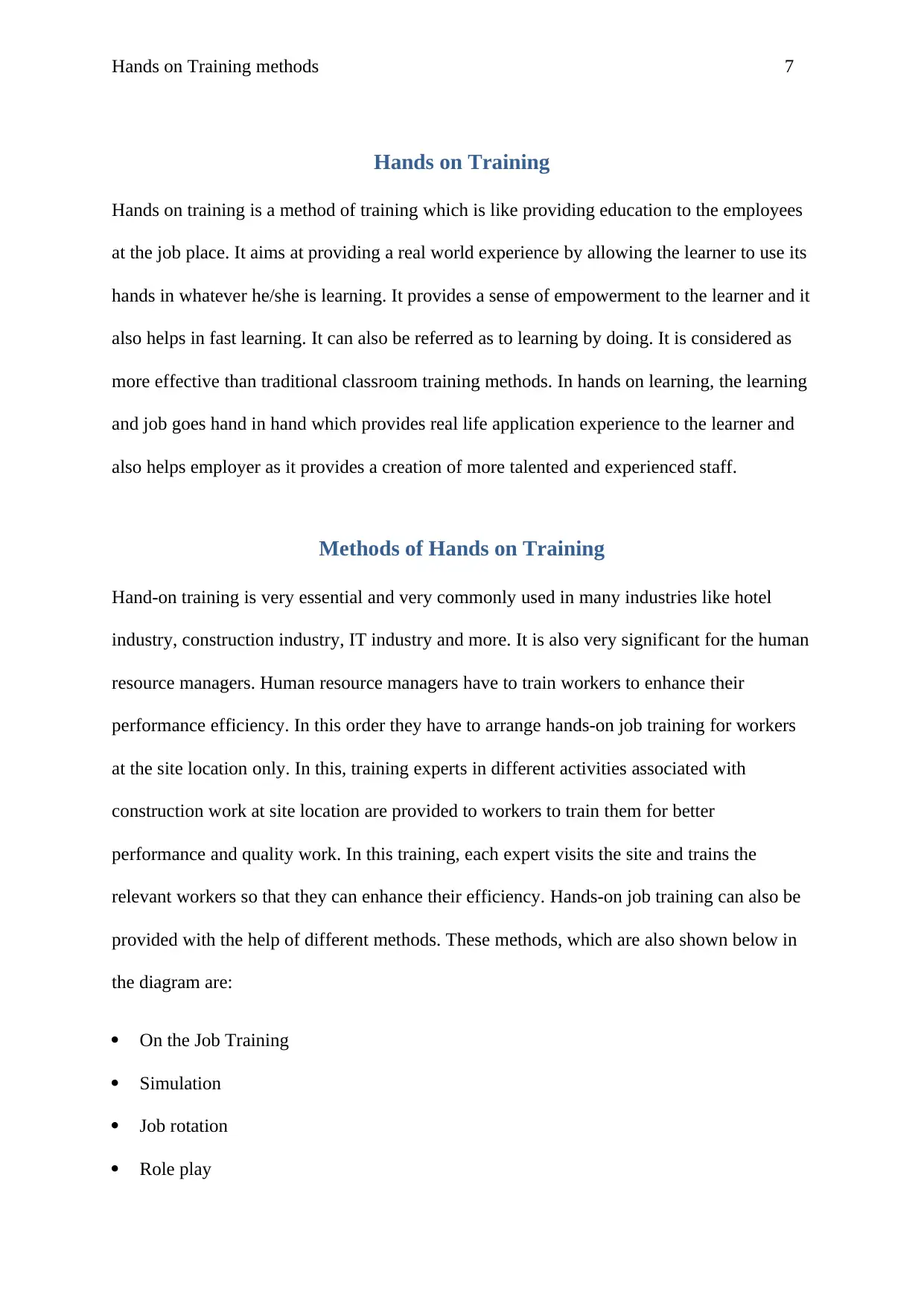
Hands on Training methods 7
Hands on Training
Hands on training is a method of training which is like providing education to the employees
at the job place. It aims at providing a real world experience by allowing the learner to use its
hands in whatever he/she is learning. It provides a sense of empowerment to the learner and it
also helps in fast learning. It can also be referred as to learning by doing. It is considered as
more effective than traditional classroom training methods. In hands on learning, the learning
and job goes hand in hand which provides real life application experience to the learner and
also helps employer as it provides a creation of more talented and experienced staff.
Methods of Hands on Training
Hand-on training is very essential and very commonly used in many industries like hotel
industry, construction industry, IT industry and more. It is also very significant for the human
resource managers. Human resource managers have to train workers to enhance their
performance efficiency. In this order they have to arrange hands-on job training for workers
at the site location only. In this, training experts in different activities associated with
construction work at site location are provided to workers to train them for better
performance and quality work. In this training, each expert visits the site and trains the
relevant workers so that they can enhance their efficiency. Hands-on job training can also be
provided with the help of different methods. These methods, which are also shown below in
the diagram are:
On the Job Training
Simulation
Job rotation
Role play
Hands on Training
Hands on training is a method of training which is like providing education to the employees
at the job place. It aims at providing a real world experience by allowing the learner to use its
hands in whatever he/she is learning. It provides a sense of empowerment to the learner and it
also helps in fast learning. It can also be referred as to learning by doing. It is considered as
more effective than traditional classroom training methods. In hands on learning, the learning
and job goes hand in hand which provides real life application experience to the learner and
also helps employer as it provides a creation of more talented and experienced staff.
Methods of Hands on Training
Hand-on training is very essential and very commonly used in many industries like hotel
industry, construction industry, IT industry and more. It is also very significant for the human
resource managers. Human resource managers have to train workers to enhance their
performance efficiency. In this order they have to arrange hands-on job training for workers
at the site location only. In this, training experts in different activities associated with
construction work at site location are provided to workers to train them for better
performance and quality work. In this training, each expert visits the site and trains the
relevant workers so that they can enhance their efficiency. Hands-on job training can also be
provided with the help of different methods. These methods, which are also shown below in
the diagram are:
On the Job Training
Simulation
Job rotation
Role play
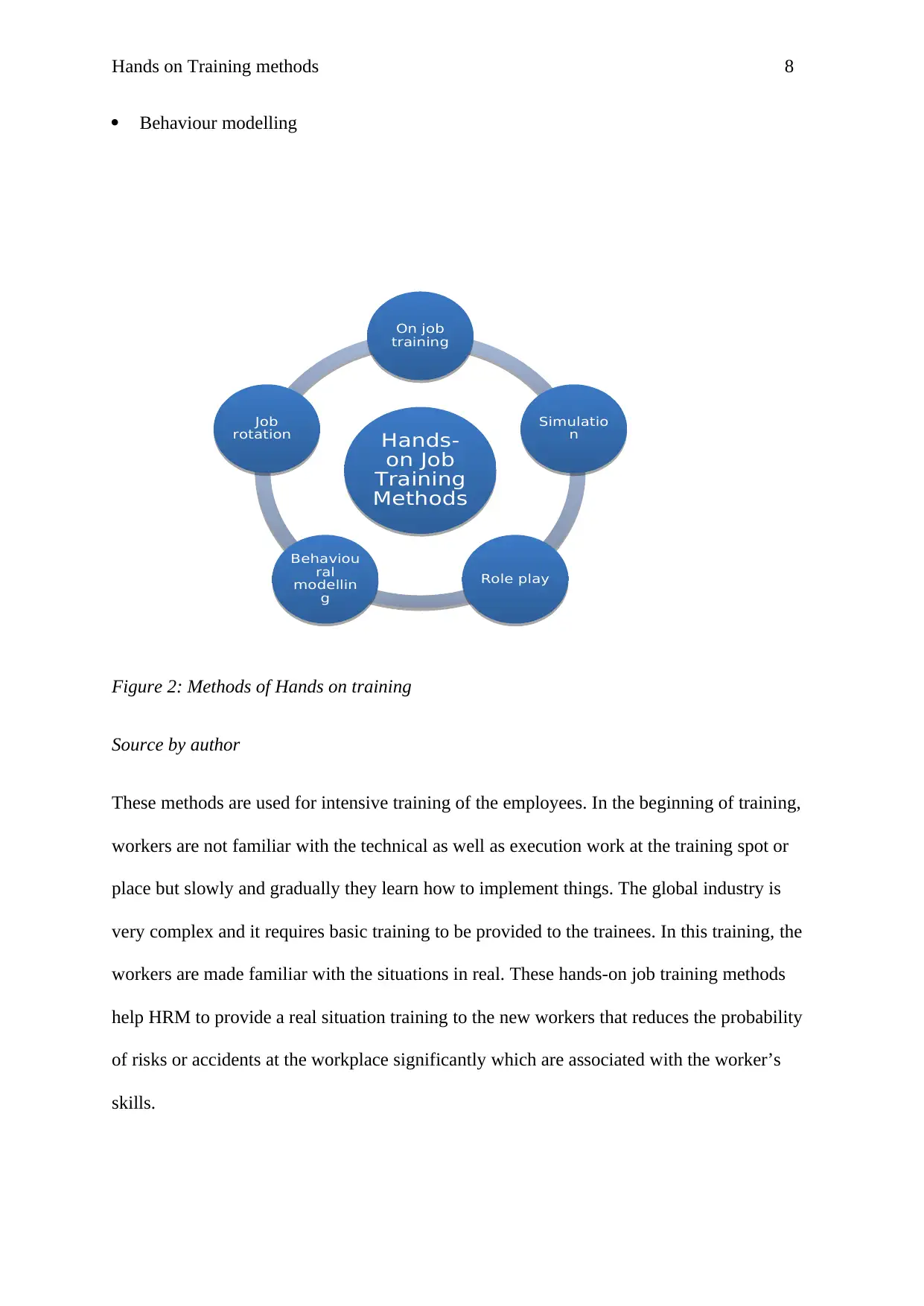
Hands on Training methods 8
Behaviour modelling
Figure 2: Methods of Hands on training
Source by author
These methods are used for intensive training of the employees. In the beginning of training,
workers are not familiar with the technical as well as execution work at the training spot or
place but slowly and gradually they learn how to implement things. The global industry is
very complex and it requires basic training to be provided to the trainees. In this training, the
workers are made familiar with the situations in real. These hands-on job training methods
help HRM to provide a real situation training to the new workers that reduces the probability
of risks or accidents at the workplace significantly which are associated with the worker’s
skills.Hands-
on Job
Training
Methods
Hands-
on Job
Training
MethodsOn job
training
On job
trainingSimulatio
n
Simulatio
nRole play
Role playBehaviou
ral
modellin
g
Behaviou
ral
modellin
gJob
rotation
Job
rotation
Behaviour modelling
Figure 2: Methods of Hands on training
Source by author
These methods are used for intensive training of the employees. In the beginning of training,
workers are not familiar with the technical as well as execution work at the training spot or
place but slowly and gradually they learn how to implement things. The global industry is
very complex and it requires basic training to be provided to the trainees. In this training, the
workers are made familiar with the situations in real. These hands-on job training methods
help HRM to provide a real situation training to the new workers that reduces the probability
of risks or accidents at the workplace significantly which are associated with the worker’s
skills.Hands-
on Job
Training
Methods
Hands-
on Job
Training
MethodsOn job
training
On job
trainingSimulatio
n
Simulatio
nRole play
Role playBehaviou
ral
modellin
g
Behaviou
ral
modellin
gJob
rotation
Job
rotation
⊘ This is a preview!⊘
Do you want full access?
Subscribe today to unlock all pages.

Trusted by 1+ million students worldwide
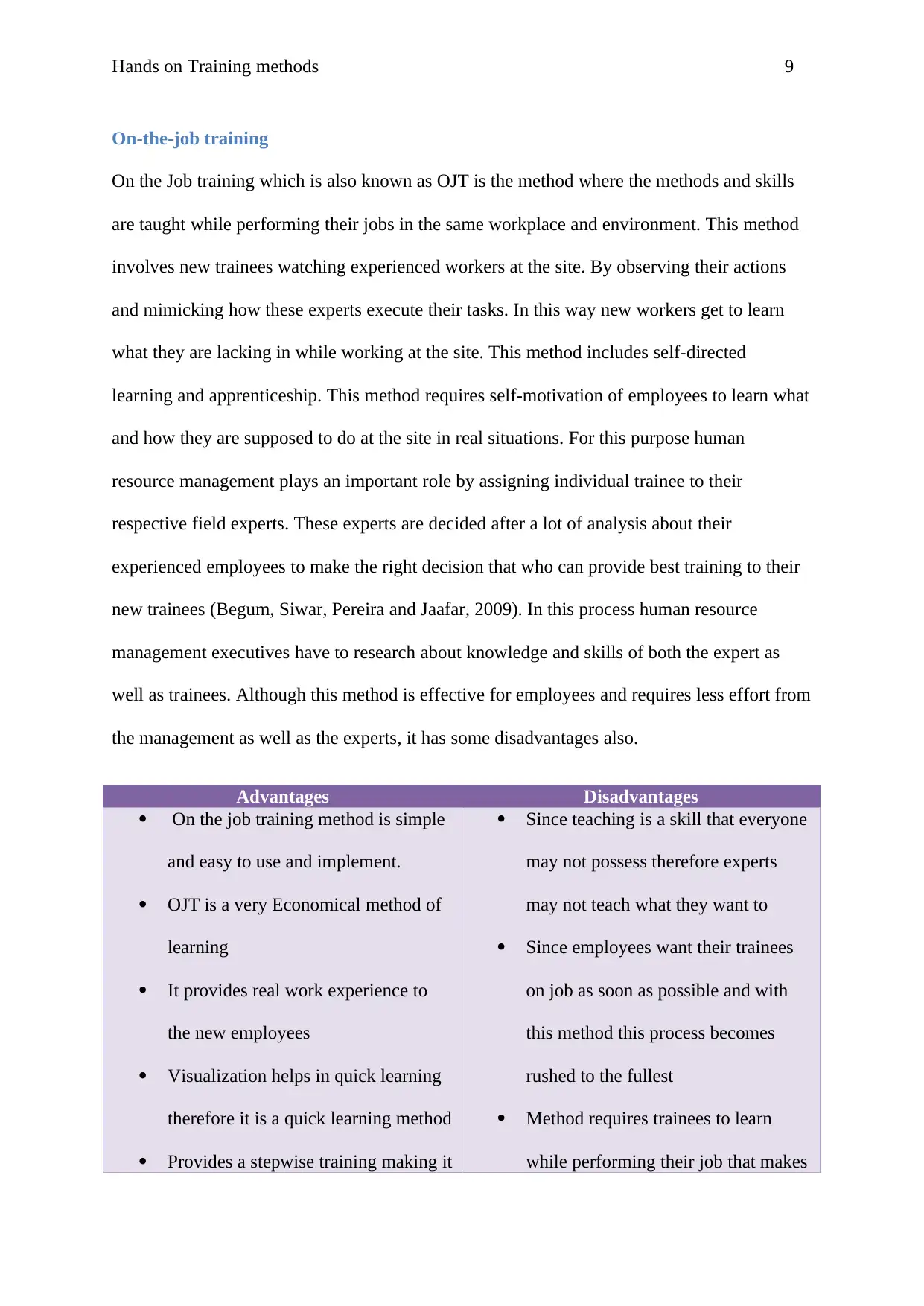
Hands on Training methods 9
On-the-job training
On the Job training which is also known as OJT is the method where the methods and skills
are taught while performing their jobs in the same workplace and environment. This method
involves new trainees watching experienced workers at the site. By observing their actions
and mimicking how these experts execute their tasks. In this way new workers get to learn
what they are lacking in while working at the site. This method includes self-directed
learning and apprenticeship. This method requires self-motivation of employees to learn what
and how they are supposed to do at the site in real situations. For this purpose human
resource management plays an important role by assigning individual trainee to their
respective field experts. These experts are decided after a lot of analysis about their
experienced employees to make the right decision that who can provide best training to their
new trainees (Begum, Siwar, Pereira and Jaafar, 2009). In this process human resource
management executives have to research about knowledge and skills of both the expert as
well as trainees. Although this method is effective for employees and requires less effort from
the management as well as the experts, it has some disadvantages also.
Advantages Disadvantages
On the job training method is simple
and easy to use and implement.
OJT is a very Economical method of
learning
It provides real work experience to
the new employees
Visualization helps in quick learning
therefore it is a quick learning method
Provides a stepwise training making it
Since teaching is a skill that everyone
may not possess therefore experts
may not teach what they want to
Since employees want their trainees
on job as soon as possible and with
this method this process becomes
rushed to the fullest
Method requires trainees to learn
while performing their job that makes
On-the-job training
On the Job training which is also known as OJT is the method where the methods and skills
are taught while performing their jobs in the same workplace and environment. This method
involves new trainees watching experienced workers at the site. By observing their actions
and mimicking how these experts execute their tasks. In this way new workers get to learn
what they are lacking in while working at the site. This method includes self-directed
learning and apprenticeship. This method requires self-motivation of employees to learn what
and how they are supposed to do at the site in real situations. For this purpose human
resource management plays an important role by assigning individual trainee to their
respective field experts. These experts are decided after a lot of analysis about their
experienced employees to make the right decision that who can provide best training to their
new trainees (Begum, Siwar, Pereira and Jaafar, 2009). In this process human resource
management executives have to research about knowledge and skills of both the expert as
well as trainees. Although this method is effective for employees and requires less effort from
the management as well as the experts, it has some disadvantages also.
Advantages Disadvantages
On the job training method is simple
and easy to use and implement.
OJT is a very Economical method of
learning
It provides real work experience to
the new employees
Visualization helps in quick learning
therefore it is a quick learning method
Provides a stepwise training making it
Since teaching is a skill that everyone
may not possess therefore experts
may not teach what they want to
Since employees want their trainees
on job as soon as possible and with
this method this process becomes
rushed to the fullest
Method requires trainees to learn
while performing their job that makes
Paraphrase This Document
Need a fresh take? Get an instant paraphrase of this document with our AI Paraphraser
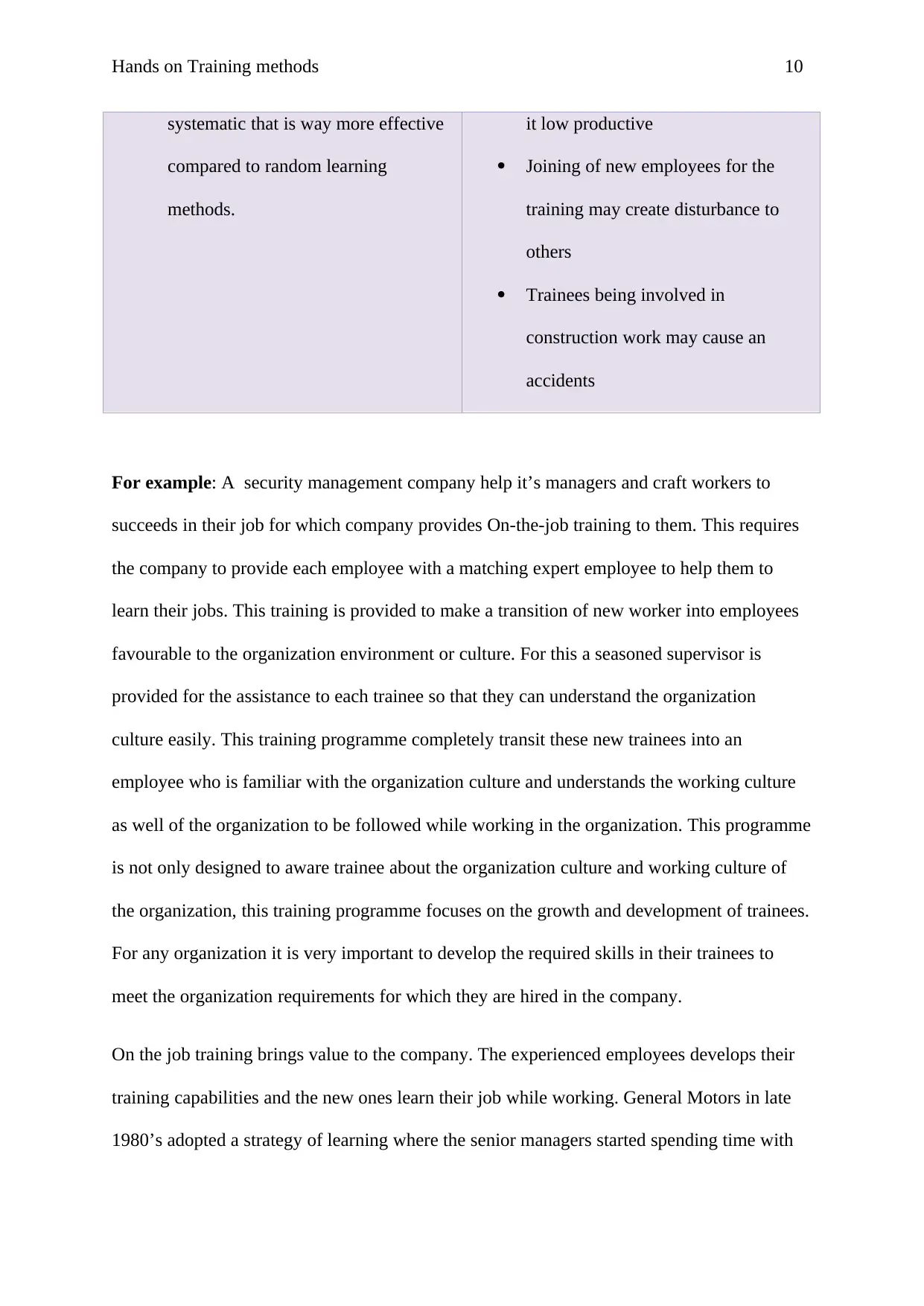
Hands on Training methods 10
systematic that is way more effective
compared to random learning
methods.
it low productive
Joining of new employees for the
training may create disturbance to
others
Trainees being involved in
construction work may cause an
accidents
For example: A security management company help it’s managers and craft workers to
succeeds in their job for which company provides On-the-job training to them. This requires
the company to provide each employee with a matching expert employee to help them to
learn their jobs. This training is provided to make a transition of new worker into employees
favourable to the organization environment or culture. For this a seasoned supervisor is
provided for the assistance to each trainee so that they can understand the organization
culture easily. This training programme completely transit these new trainees into an
employee who is familiar with the organization culture and understands the working culture
as well of the organization to be followed while working in the organization. This programme
is not only designed to aware trainee about the organization culture and working culture of
the organization, this training programme focuses on the growth and development of trainees.
For any organization it is very important to develop the required skills in their trainees to
meet the organization requirements for which they are hired in the company.
On the job training brings value to the company. The experienced employees develops their
training capabilities and the new ones learn their job while working. General Motors in late
1980’s adopted a strategy of learning where the senior managers started spending time with
systematic that is way more effective
compared to random learning
methods.
it low productive
Joining of new employees for the
training may create disturbance to
others
Trainees being involved in
construction work may cause an
accidents
For example: A security management company help it’s managers and craft workers to
succeeds in their job for which company provides On-the-job training to them. This requires
the company to provide each employee with a matching expert employee to help them to
learn their jobs. This training is provided to make a transition of new worker into employees
favourable to the organization environment or culture. For this a seasoned supervisor is
provided for the assistance to each trainee so that they can understand the organization
culture easily. This training programme completely transit these new trainees into an
employee who is familiar with the organization culture and understands the working culture
as well of the organization to be followed while working in the organization. This programme
is not only designed to aware trainee about the organization culture and working culture of
the organization, this training programme focuses on the growth and development of trainees.
For any organization it is very important to develop the required skills in their trainees to
meet the organization requirements for which they are hired in the company.
On the job training brings value to the company. The experienced employees develops their
training capabilities and the new ones learn their job while working. General Motors in late
1980’s adopted a strategy of learning where the senior managers started spending time with
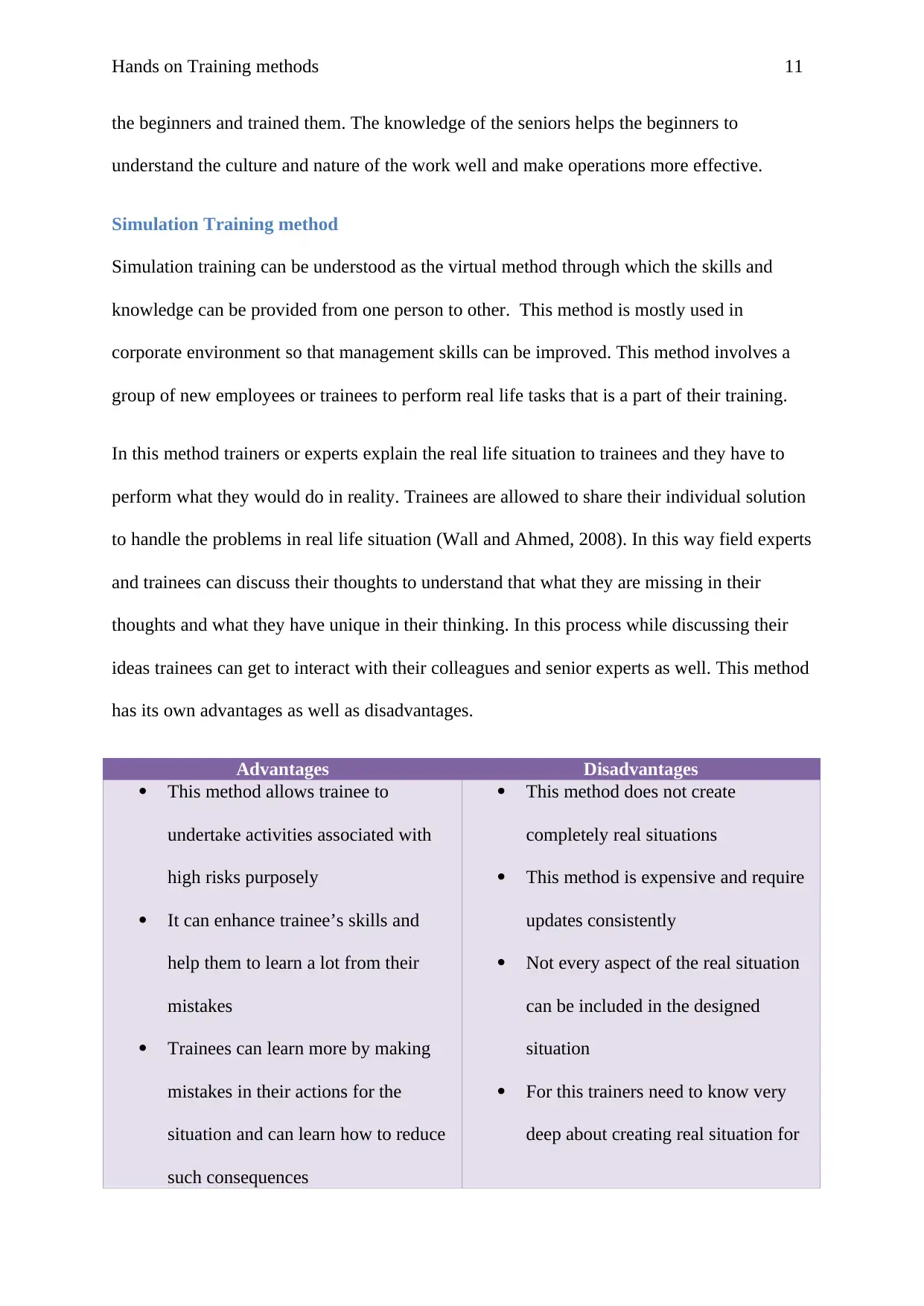
Hands on Training methods 11
the beginners and trained them. The knowledge of the seniors helps the beginners to
understand the culture and nature of the work well and make operations more effective.
Simulation Training method
Simulation training can be understood as the virtual method through which the skills and
knowledge can be provided from one person to other. This method is mostly used in
corporate environment so that management skills can be improved. This method involves a
group of new employees or trainees to perform real life tasks that is a part of their training.
In this method trainers or experts explain the real life situation to trainees and they have to
perform what they would do in reality. Trainees are allowed to share their individual solution
to handle the problems in real life situation (Wall and Ahmed, 2008). In this way field experts
and trainees can discuss their thoughts to understand that what they are missing in their
thoughts and what they have unique in their thinking. In this process while discussing their
ideas trainees can get to interact with their colleagues and senior experts as well. This method
has its own advantages as well as disadvantages.
Advantages Disadvantages
This method allows trainee to
undertake activities associated with
high risks purposely
It can enhance trainee’s skills and
help them to learn a lot from their
mistakes
Trainees can learn more by making
mistakes in their actions for the
situation and can learn how to reduce
such consequences
This method does not create
completely real situations
This method is expensive and require
updates consistently
Not every aspect of the real situation
can be included in the designed
situation
For this trainers need to know very
deep about creating real situation for
the beginners and trained them. The knowledge of the seniors helps the beginners to
understand the culture and nature of the work well and make operations more effective.
Simulation Training method
Simulation training can be understood as the virtual method through which the skills and
knowledge can be provided from one person to other. This method is mostly used in
corporate environment so that management skills can be improved. This method involves a
group of new employees or trainees to perform real life tasks that is a part of their training.
In this method trainers or experts explain the real life situation to trainees and they have to
perform what they would do in reality. Trainees are allowed to share their individual solution
to handle the problems in real life situation (Wall and Ahmed, 2008). In this way field experts
and trainees can discuss their thoughts to understand that what they are missing in their
thoughts and what they have unique in their thinking. In this process while discussing their
ideas trainees can get to interact with their colleagues and senior experts as well. This method
has its own advantages as well as disadvantages.
Advantages Disadvantages
This method allows trainee to
undertake activities associated with
high risks purposely
It can enhance trainee’s skills and
help them to learn a lot from their
mistakes
Trainees can learn more by making
mistakes in their actions for the
situation and can learn how to reduce
such consequences
This method does not create
completely real situations
This method is expensive and require
updates consistently
Not every aspect of the real situation
can be included in the designed
situation
For this trainers need to know very
deep about creating real situation for
⊘ This is a preview!⊘
Do you want full access?
Subscribe today to unlock all pages.

Trusted by 1+ million students worldwide
1 out of 22
Related Documents
Your All-in-One AI-Powered Toolkit for Academic Success.
+13062052269
info@desklib.com
Available 24*7 on WhatsApp / Email
![[object Object]](/_next/static/media/star-bottom.7253800d.svg)
Unlock your academic potential
Copyright © 2020–2025 A2Z Services. All Rights Reserved. Developed and managed by ZUCOL.



